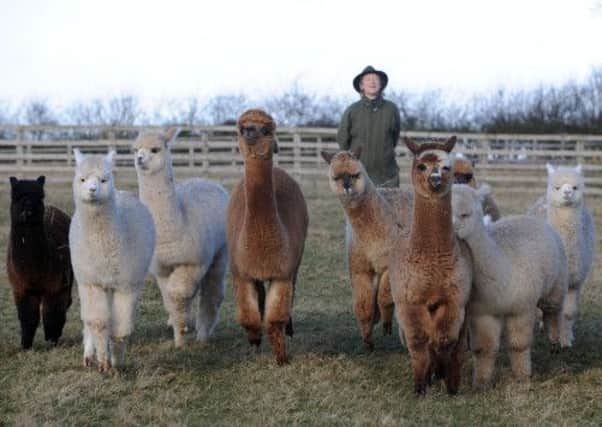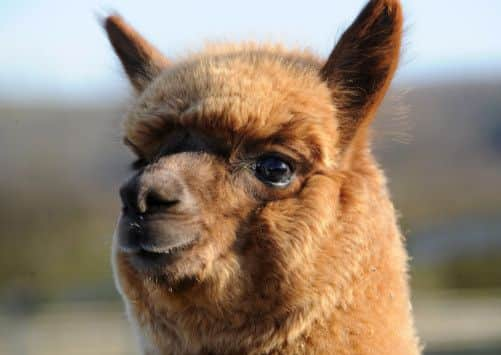The wild bunch goes on fox patrol


If, on a cold, bright North Yorkshire morning, you take one of the many footpaths that connect the lazy curves of the River Derwent to the surrounding patchwork of farmland between Howsham and Crambe, you may find yourself rounding a tall hedge and coming face to face with a herd of friendly neighbourhood alapacas.
It’s hard to imagine a more appealing animal. Their inquisitive behaviour is more suggestive of much-loved pets than livestock, but for the couple behind Fowberry Alpacas, the herd is also business.
Advertisement
Hide AdAdvertisement
Hide AdIt was back in 2009 that Jenny and Graham MacHarg moved their home and their animals from Northumbria to where the land begins a gentle rise from the Vale of York to the Wolds and Howardian Hills. This green and pleasant corner of Yorkshire is a world away from the dry plateux of the High Andes, but the alpaca look quite at home. And if Jenny has her way, they will become a familiar sight on farms all over the country.


Alpacas have been farmed in their native South America for millennia, but it wasn’t until the 1980s that the industry spread to Australia. The animals’ fine, soft wool proved a lucrative sideline to the country’s already extensive textile industry and the Aussie farmers were also quick to notice another advantage: when they placed alpaca among their flocks of sheep they no longer lost lambs to foxes, dingoes or eagles. The concept of alpacas herd guards was born and it’s one Jenny is keen to promote.
“Two years ago we sold on a stud we had bred,” she says as we enter the first paddock full of recently weaned youngsters. “He came back to us three weeks ago and when I called to him in the trailer he immediately recognised my voice. He bent straight down to look out of the vent and went into a submissive posture, which a mature male would never normally do, ears pricked and tail curled forward, he came right up to my face to sniff my mouth. Some people are talking about using non-breeding alpacas for meat. I could never eat an animal as intelligent as that.”
And this is the crux of it. Gelded male alpacas (known as wethers) need jobs. And guarding vulnerable livestock is one they are exceptionally good at. Their protective instinct is so strong that they can adopt a herd of sheep, or a flock of chickens, in a matter of minutes.
Advertisement
Hide AdAdvertisement
Hide Ad“One very cold morning I went to check on our lambing ewes and found the alpacas clustered away from the main mob,” says Australian farmer Debbie O’Neill, who runs Signature Alpacas in New South Wales. “In between them was a lamb less than 12 hours old. Mum had died and it wouldn’t have lasted the night by itself but was snug and alive, thanks to the alpacas.”
Alpaca wethers also act as nannies, overseeing large numbers of lambs while ewes graze. When the ewes move on, the guards chivvy their youngsters to follow, keeping the herd together, the lambs safe and the ewes, who aren’t the most diligent of mothers, relaxed.
“One year we had a large number of triplets amongst our Merino ewes,” says Debbie. “They don’t have the best mothering ability, and we had come to expect losses. But the alpacas made sure no lambs were left behind and we had an extremely high survival rate.”
Debbie’s experience is typical – other Australian farmers report up to 50 per cent increases in lambing survival rates after the introduction of alpaca guards and alpaca keepers in the UK have similar stories to tell. Sheep here may not be troubled by dingoes or wedge-tailed eagles, but alpacas are more than a match for any of the animals liable to trouble British flocks.
Advertisement
Hide AdAdvertisement
Hide Ad“The display they put on is intimidating,” says Jenny. “They actively confront a fox, and what other animal in the UK will do that?”
Foxes that do not slink away in the face of an alpaca advance, or those unfortunate enough to be cornered, are liable to be trampled to death. Dogs are driven back from boundary fences by fierce glares, squeals and stamping and buzzards are harried from their perches. The relatively few British farms that have taken on alpacas have seen predation losses fall despite increasing fox numbers. Prince Charles is a convert – alpacas run with his rare breed sheep in Gloucestershire, with dramatic improvement in lambing success.
Jenny notes that the foxes she sees around their farm have adopted a belly crawl in an effort to avoid detection. It doesn’t work. Here, nothing moves without sharp eyes noticing, and unwelcome visitors are given short shrift.
Francesca, one of Jenny’s prized females is a 13 times show champion and the boss of her herd. In 2008 she had just given birth to her first son, when a stoat approached, attracted by the smell of blood. Francesca’s older daughter, Katrina, tried to drive the stoat away but it fought back, and attached itself to her nose.
Advertisement
Hide AdAdvertisement
Hide AdAt this point, 15 minutes after giving birth, Francesca stepped in. She chased down the stoat and trampled it to death. She would, Jenny assures, have no hesitation meting out the same treatment to a fox, and a quick glance at Francesca’s feet left no doubts – alpaca hooves are robust, pointed and clearly more than adequate weapons.
Female alpacas like Francesca can be just as effective as males at guarding, but they have other roles.
“A female that has worked hard all her life producing quality animals has really done her bit, so our retired girls are mollycoddled – I wouldn’t ever send them off to do any guarding. But males that aren’t good enough to breed don’t have any work to do, all they do is grow fleece, and so for them, guarding is ideal.”
After a few minutes of baby talk with Jenny’s newly weaned youngsters, we set off across the field. The alpacas gently jostle and bump us as we go, proving that if there is something strange in their neighbourhood, they really do get involved. “Alpacas love routine,” says Jenny. “They like people they know, they don’t like foxes or dogs, even though they’re not really a threat.
Advertisement
Hide AdAdvertisement
Hide Ad“The alpacas don’t know they’re not living in the Andes – their reactions to anything that might be a predator are inbuilt, and they don’t need any training.” But, it seems, you do need the right alpaca.
“We once had two males come to us together. One seemed to think he was a girl. In cold weather he was happy to tuck himself at the back of the shelter, not in any way concerned, while the other boy was always by the door, constantly looking out, all responsibility and attentiveness. Breeders know which of their boys will make good herd protectors.”
Jenny explains that an alpaca can begin guarding at two to three-years-old, they improve with experience and may work for up to 15 years. Why then does every sheep and chicken farm in Britain not already have a few alpacas on patrol?
“How do I say this? Some – a lot – of farmers are a little stuck in their ways,” says Jenny. “I appreciate that alpacas require some extra care, but they don’t want to explore the possibilities.
Advertisement
Hide AdAdvertisement
Hide Ad“The animals come from the Andes and the UV levels from sunshine there can’t be replicated here so they have to have supplements of minerals and vitamins for example to avoid rickets. They need shearing once a year and their hooves clipping from time to time. And in winter they need shelter, something like a three-sided garden shed.
“If farmers don’t do those things it’s like buying a tractor and not servicing or maintaining it. But it’s not too much to ask in return for saving say, 30 lambs in a season.”
There are other benefits to keeping alpacas. Their wool sells for as much as £100 a kilo, so a single shearing might recoup much of an animal’s purchase price. Farmers diversifying into tourism find these docile, friendly and attractive beasts are an undoubted draw to visitors, so wethers can earn their keep even outside the lambing season. And business considerations aside, it has to be said – these are lovely animals to be around.
ALPACA ORIGINS
The alpaca is something of a newfangled species in evolutionary terms, a descendant of the dainty but hardy vicuña. The process of domestication began between 6,000 and 7,000 years ago.
Advertisement
Hide AdAdvertisement
Hide AdThe Pukara people of Lake Titicaca were early alpaca breeders, but the power of systematic selective breeding was fully exploited by the Inca.
Archaeological remains suggest that Inca alpaca fibre was finer than that known today. The deterioration in quality results from uncontrolled crossbreeding with llamas during the chaotic centuries that followed the Spanish conquest of South America, when native people and their livestock were decimated and forced into marginal lands.
This hybridisation also lead to two centuries of confusion surrounding the origin of the alpaca – over the years zoologists speculated, proposed and counterproposed a variety of possibilities – that alpacas descended from the guanaco, from an extinct wild alpaca, were the result of a cross between a llama and vicuña or just a special breed of llama. Molecular analysis has finally cleared up all confusion, and the alpaca was recently renamed scientifically as Vicugna pacos, reflecting its true ancestry.